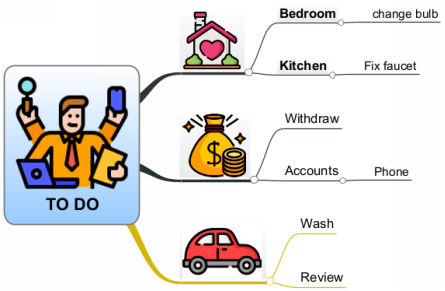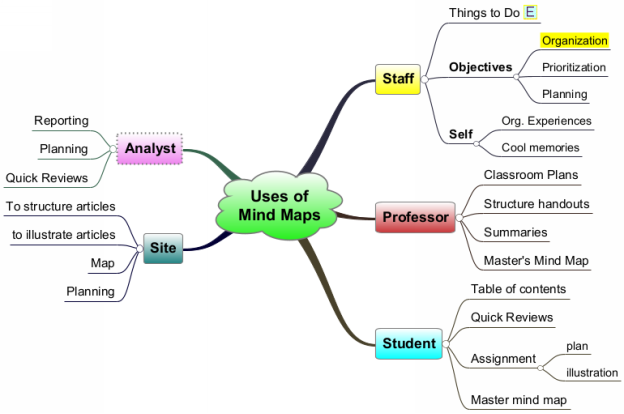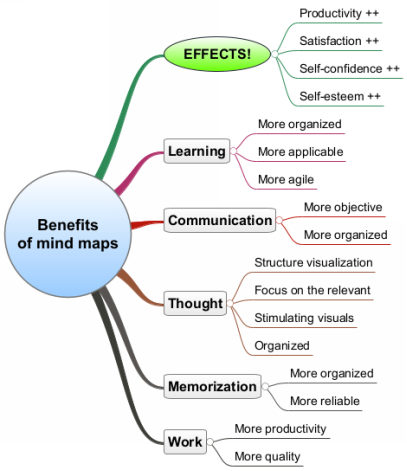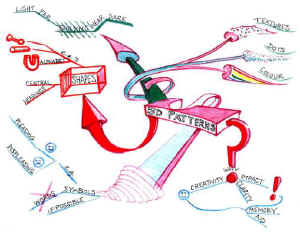Start/Know
We never forget our first mind map
An introduction to mind maps, their applications, and benefits
We cannot desire what we do not even know exists and what it can be used for. Read in this article a quick introduction to mind maps in the form of a story, showing some uses and benefits of this practical and very useful tool.
A solutions guy
Jordan is a busy guy: he is an analyst, a teacher, a student, a father and has a website. He usually has several things to do, and he likes to write them down so he doesn't forget. Initially, he made a simple list, written down on any piece of paper:
- Wash the car
- Take the car in for service
- Fix kitchen sink leak
- Pay the phone bill
- Withdraw money
- Change the bedroom light bulb
Later, Jordan discovered that it was better to group the items:
Car
- Wash
- Take in for service
House
- Fix kitchen sink leak
- Change bedroom light bulb
Finance
- Pay phone bill
- Take money
But Jordan really liked it when he found an excellent program for creating mind maps and made a first version like this, with the same items:

Exploring the program, he saw that he could insert images in the topics:

Now, Jordan, who has dozens of things to do, only uses mind maps to remember them.
And he, who is an analyst, teacher, student, parent and has a website, used the maps in several ways: to plan classes and handouts, present summaries to students, prepare reports and even to better organize his self-criticism, recording the various aspects and possible approaches.
Convinced of the advantages, he decided to organize the possible uses of mind maps also in a mind map, where he considered each of his activities and inserted another topic for the personal part.

By showing this and other mind maps to people and students, Jordan soon discovered that many tried to look at the map all at once, and "freaked out". But he taught them to look at the beginning at just the title and one topic at a time, and soon they were enjoying it. One of them even commented on the advantage of "having almost no articles and prepositions or blah blah blah, just structure".
Not satisfied, Jordan wanted to have a very clear and organized view of the benefits of using mind maps and made the mind map below.
On the first level, that of the main topics, he placed the various aspects of life that they benefited: work, learning, memorization and others, and on the next level, the benefits he had already perceived. He highlighted on the map what for him is the most important in the chain of benefits: the personal effects that result from them. And he nailed the mind map in a very visible place.

Jordan also taught his preteen son how to make the maps and gave him a "junior" version of a mind mapping app. The smart boy also liked the thing and soon he was making mind maps for his school subjects, studying through them and even making money selling them to his classmates!
Our hero even saw a book with several mind maps, made by hand. Some he found very visually polluted, others were interesting, there was even a very artistic one:

(Tony Buzan, The Mind Map Book)
Very cool, yes, but he really didn't have time for all this art, and he thought he was very well served by the program he used. It was easy to change content and rearrange topics, which he did a lot, easy to highlight fonts and colors, easy and cheap to generate colored copies, good for presentations and even to distribute to the whole world, if that was the case.
Jordan was really satisfied. And he began to notice something very interesting: as he practiced, applied and lived with mind maps, he noticed that it was easier and easier to build the maps in his thoughts, and for some situations he didn't even need paper anymore. A very interesting possibility for him lurked in from the future...
See also:
An introduction to mind maps so you can evaluate how they can improve your life.

